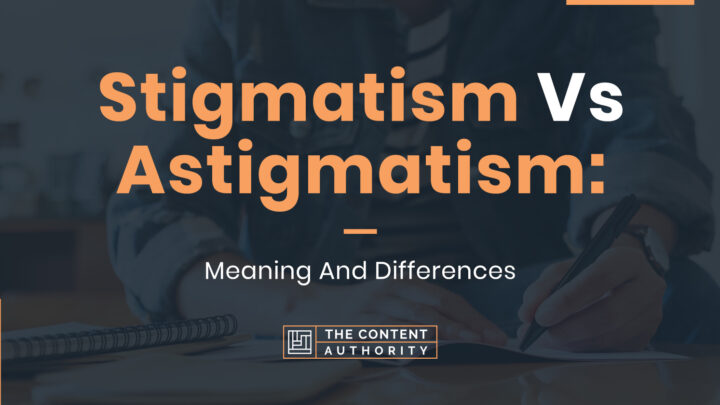Have you ever encountered the word stigmatism or astigmatism? If so, do you know what they mean? If you don’t, you need not worry because we will inform you about stigmatism vs astigmatism.
“Stigmatism” refers to normal eyesight or a stigmata state. Also, an image-formation element of an ophthalmic system focusing on a single point font in object space or in image space. In contrast, astigmatism is a medical vision disorder resulting from an irregular cornea or a lens defect.
You now have an idea of the definition of stigmatism and how the word is different from astigmatism. So, can you use these words as each other’s synonyms or antonyms? Find out in this article as we look more into the words’ usage and example sentences.

Definition Of Stigmatism And Astigmatism
In English, the letter “a” is sometimes added in front of a word to indicate an opposite meaning or an antonym. For example, symmetry and asymmetry. Therefore, it is easy to assume that stigmatism and astigmatism are synonyms.
However, this rule does not apply to all words, and a good example is the words stigmatism and astigmatism. The case with stigmatism and astigmatism is slightly confusing because, depending on the meanings, these words can sometimes serve as opposites and sometimes cannot serve as each other’s antonyms. The definitions below will give you more insight into this.
Definition Of Stigmatism
In optics, stigmatism refers to an optical system condition where light rays from a single point converge in one focal space or point. This definition might seem complex to non-physics enthusiasts, so let us break it down.
Here is what the above means: “Stigmatism” is a state in an optical system like a reflecting or refracting system where light rays from one point accurately converse at one point. For example, in a sentence, “Physical stigmatism was my favorite topic taught by the optics professor.”
In medicine or pathology, stigmatism is a medical condition where stigmata exist in someone’s body. Stigmata is the plural of stigma, which refers to a scar, birthmark, or mark on someone’s body resembling the ones left on Jesus’ body after the crucifixion. In a sentence, “The crucifixion marks on Jesus’ body are the perfect example of stigmatism.”
Also, in medicine, especially in the eye’s anatomy, stigmatism refers to “normal eyesight.” For example, in a sentence, “Stigmatism is a common term in optician clinics referring to an anastigmatic or normal eyesight state.”
Finally, stigmatism means “related to the social stigma associated with unfair treatment of minorities or disapproved behaviors in society.” For example, “The stigmatism of minorities in the United States has lasted for centuries.”
Definition Of Astigmatism
In optics, astigmatism refers to an optical system defect where light rays from one point do not converge in one focal space. For example, in a sentence, “Astigmatism in the optical system will hinder the experimental results.”
In medicine, astigmatism refers to an optical flaw where the uneven curvature of refractive surfaces on the eye, like the cornea, forces the light rays not to focus clearly at one point on its retina.
In simpler terms, astigmatism is a visual disorder that causes blurred images because of a misshapen cornea that prevents proper light focusing. An example sentence is, “The ophthalmologist discovered that my grandma has astigmatism in her left eye.”
How To Properly Use Stigmatism And Astigmatism In A Sentence
Many argue that these words are hard to apply in regular non-medicine-related sentences. However, as long as you understand the meaning of a word, you can use it anywhere where the context makes sense. Here are some things you should bear in mind about the proper use of stigmatism and astigmatism in sentences.
How And When To Use Stigmatism
Use this word as a noun when referring to image-formation properties in an optical system where light from a single point source converges on a single space. For example, “Stigmatism is not a hard concept to explain.”
Also, use this word as a noun for normal eyesight and a state of having stigmata. For example, “Stigmatism is another term for an anastigmatic state.”
Do not forget the rules for using nouns in sentences when using this word. For instance, when a noun is a subject, the sentence should feature a verb placed before or after the noun. In a sentence, “The students studied stigmatism during their first semester.” In this sentence, the subject is “stigmatism,” and the verb is “studied.”
How And When To Use Astigmatism
Use astigmatism as the opposite of stigmatism. In addition to this, the usage rules are similar for both words. That means you can use the tips in the section above when using “astigmatism” in sentences. However, ensure you are keen on the context in which you use this word to oppose stigmatism.
Stigmatism vs. Astigmatism: A Few More Differences
In English, adding the prefix “a” to a word indicates that it is negative. Therefore, the primary difference between these words is that astigmatism is the opposite of stigmatism.
Besides their definitions, another difference between astigmatism and stigmatism is their history and etymology. Multiple sources indicate that the word “stigmatism” came about in the 1660s from the Greek “stigmatizein,” meaning conditions from being affected by stigmata.” However, the word took other meanings in medicine and optics in the late 1800s and early 1900s.
The word “astigmatism,” meaning “an eye structure defect that prevents light from converging at a single point on the retina,” was coined in 1849 by the English polymath Rev. William Whewell. The English polymath coined this term by adding the Greek “a” meaning “without” to the word “astigmatism.”
Other elements that differentiate these words are their pronunciation and number of syllables. “Stigmatism” has three syllables, “stig-ma-tism,” and its correct pronunciation is “/stig-muh-tiz-um/.” In contrast, “astigmatism has four syllables, “a-stig-ma-tism,” and its proper pronunciation is “/uh-stig-muh-tiz-um/.”
Examples Of Stigmatism And Astigmatism Use In Sentences
The definitions for stigmatism and astigmatism are not as complex as they seem. Their applications are also not complex. So, you can easily use these words in sentences. Here are a few sentence examples to give you an idea of how you can apply these words:
Example sentences of stigmatism
- The stigmatism in the optical system will ensure perfect experimental results.
- The optics professor gave the best stigmatism lecture last Wednesday.
- I failed my optics exam because I did not cover the stigmatism topic while revising.
- John’s stigmatism excluded him from the experiment because the researchers wanted subjects with abnormal eyesight.
- The stigmatism of African Americans in the United States has caused global outcries for the first time in centuries.

Example sentences of astigmatism
- The astronomer made news headlines by correcting his astigmatism while working on the space station.
- The doctors will publish a paper on the causes of astigmatism among older adults.
- The wound is too small to be the cause of astigmatism.
- The experiment failed because of astigmatism in the lens and mirror system.
- My mother suffers from blurred vision because of astigmatism in her cornea.
Conclusion
The definitions for stigmatism and astigmatism may seem complex at first read. However, when you do not look at them as complex medical or physics jargon, you will realize that the meanings are pretty simple. The beauty about words like stigmatism and astigmatism (those that use the prefix “a” to indicate an opposite) is that once you understand one of their definitions, you are good to go.
However, in this post, we researched all the possible meanings of both words to help you understand them further and their differences. So, feel free to read this piece to comprehend, and you will be happy to use the words without fear of making mistakes.
Shawn Manaher is the founder and CEO of The Content Authority. He’s one part content manager, one part writing ninja organizer, and two parts leader of top content creators. You don’t even want to know what he calls pancakes.

